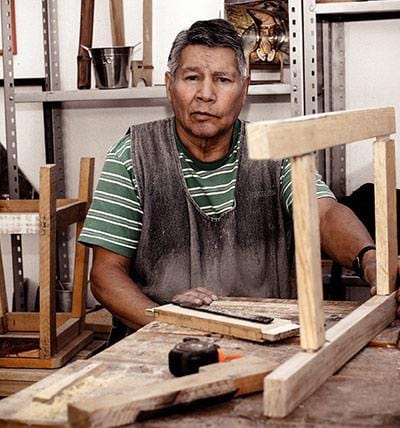What is the Difference Between a French Rolling Pin and a Regular Rolling Pin? Best Rolling Pin
Jul, 15When rolling out dough like a pro, bakers have various options. Two popular kitchen choices often take center stage are the French rolling pin and the regular rolling pin. These culinary companions may seem similar at first glance, but they bring their unique flair to dough manipulation. Picture this: Armed with a trusty rolling pin, a baker sets out to conquer the realm of pie-making. Will they choose the sleek elegance of a French pin or opt for the tried-and-true handle of a regular pin? As we embark on a delicious journey into pastry perfection, Let's explore the differences between these rolling pin contenders, pie dough flying and flour-dusted. But first, let's pour ourselves a glass of wine, kick back, and indulge in the warm, flaky discourse that awaits us. So, without further ado, grab your favorite rolling pin and uncover the secrets behind the doughy magic that awaits.
Understanding the Distinction: French Rolling Pin vs. Regular Rolling Pin
Today, we'll delve into the culinary world's nitty-gritty and decipher the key differences between two rolling pins: the French rolling pin and its regular counterpart. Now, these aren't your run-of-the-mill kitchen utensils, mind you. No, sir! These babies are the masters of flattening the dough and conquering crusts. So, let's get rolling and uncover the distinctive qualities that set them apart.
First, the French rolling pin isn't your typical, no siree! Picture this: a sleek, solid wooden dowel with no handles. Yup, no fancy grips or gizmos here. It's all about simplicity, baby. On the flip side, the regular rolling pin boasts handles on either side for extra maneuverability. But don't let appearances fool you! It's what's under the hood that counts.

Now, when it comes to rolling out that pie crust or flattening pastry dough to perfection, the French rolling pin takes the cake. Literally! With its tapered ends, this bad boy allows you to control the thickness of your dough with finesse. No more uneven crusts or lumpy fillings! Plus, the absence of handles allows you to apply just the right amount of pressure. Talk about precision, my friends!
On the other hand, the regular rolling pin may be a tad more versatile. You see, it comes in various shapes and materials. You've got the classic wooden rolling pin, reliable as ever with its sturdy heft and timeless charm.
Then there's the sleek marble rolling pin, cool and perfect for chilling that cookie dough. Let's not forget the nylon or silicone wonders, which are great for non-stick rolling. Heck, if you're in a pinch, you can grab that trusty ol' wine bottle and whirl it!
But wait, there's more! If you're looking to keep those wooden beauties in tip-top shape, a little TLC goes a long way. Treat them to a mineral oil massage to keep them looking shiny and new. Oh, and one more thing, folks: these rolling pins prefer a gentle hand wash, so keep them out of that dishwasher!
Exploring Different Rolling Pin Styles: Wooden, Marble, and More
Today, we'll take a deep dive into the world of rolling pins and explore the different styles out there. So, if you're ready to rock and roll in the kitchen, let's start this dough party!
First up, we've got the classic wooden rolling pin. Ah, the tried and true favorite of many bakers. These wooden pins come in all shapes and sizes, from the straight rolling dowel to the tapered French rolling pin. Let me tell you, these bad boys have stood the test of time. Take the Fox Run or the Adams Maple, for example. They're the kings of wood rolling pins, providing the perfect heft and balance you need to roll out pie dough like a pro. Keep them clean and dusted with flour; you're good to go!
If you want to add a touch of elegance to your baking game, marble rolling pins are where it's at. These babies are as cool as a cucumber and are great for working with pastry. Imagine yourself rolling out that dough even and smooth, with a luxurious marble pin gliding across the surface. Talk about fancy, huh?
But hold your horses, folks! We've got more styles to explore. How about the handled rolling pins? Yeah, those with grips on either end. They come in handy when dealing with larger batches of dough or tackling pizza crusts. Some folks swear by them, claiming they provide better control and leverage. J.K., the choice is yours!
Now, let's talk dough thickness. Different pins work better for different kinds of dough. If you're going for thinner creations like cookies, a smaller, straight-rolling pin might be your go-to. On the other hand, if you're looking to conquer larger pastries or bread, a longer pin with tapered ends will be your secret weapon.
When it comes to rolling pin material, wood is the name of the game. Most professional bakers and home cooks prefer the feel and weight of a wooden pin. But hey, if you're into trying new things, there are also pins made from other materials like silicone or stainless steel. Just remember to stick to what works for you, my friends.
Now, let's address the elephant in the kitchen. How the heck do you keep the dough from sticking? Well, it's simple. Flour up that surface and the pin. And if you're working with delicate dough, like pastry, you can use a clean, lint-free cloth to apply a bit of flour as you go. Treat that dough like royalty, my friends.
So, there you have it! A whirlwind tour of rolling pin styles that'll have you rolling in no time. Whether you're a fan of the wooden wonders, the marble marvels, or the handled heroes, it all boils down to your preference and what works best for your baking adventures. So go forth, my friends, and conquer that dough with the right rolling pin.
The Benefits of a French Tapered Rolling Pin: Why It's Worth Considering
If you're searching for the perfect rolling pin to enhance your baking experience, it's worth considering the benefits of a French tapered rolling pin. Now, let me tell you why it's worth your while. We've put numerous rolling pins to the test, from the classic ones with handles to the gourmet and vintage varieties. But let me tell you, there's something special about a French-style tapered pin.
Picture this: as you use it to roll out your dough, the tapered ends effortlessly guide your movements, allowing you to create beautifully thin and even sheets of pastry. It's a game-changer, my friend! These rolling pins are generally made of wood, adding a touch of rustic charm to your kitchen and providing a sturdy and reliable tool for your baking adventures. Oh, and did I mention the dough doesn't stick to it as much as with other pins? That's right! The smooth surface of a French tapered pin ensures a seamless rolling experience, with minimal flour and dough residue left behind. You can treat it as you would a trusted friend—give it a good dusting of flour, and it won't let you down.
Now, let's talk about versatility. The French tapered rolling pin is a master of all trades. Whether rolling out pie crusts, making cookies, or crafting homemade pasta, this pin has your back. Its smaller size than dowel rolling pins makes it easier to maneuver and control. It's perfect for rolling out delicate doughs like puff pastry or applying the right amount of pressure when working with pizza dough. Plus, its ergonomic design ensures a comfortable grip, giving you the confidence to conquer any baking project that comes your way.
I'm not here to sing its praises without mentioning its potential downsides. One thing to consider is that French tapered rolling pins don't have handles.
Some bakers prefer the stability and control offered by handled pins, especially when dealing with heavy or stiff doughs.
It's a matter of personal preference. Also, remember that while wooden rolling pins are durable and long-lasting, they require a bit of maintenance.
Please treat it carefully, oil it occasionally, and avoid immersing it in water to ensure longevity.
So, if you're ready to level up your baking game, why not give a French tapered rolling pin a whirl? Trust me, once you experience the effortless rolling, the precision, and the satisfaction of creating baked goods with finesse, you'll wonder how you ever managed without one.
Choosing the Best Rolling Pin: Factors to Consider, from Material to Design
When choosing the best rolling pin for your kitchen, a few factors will make your decision a piece of cake. Now, let me break it down for you. We've put various rolling pins to the test, from the classic ones with handles to the gourmet and vintage varieties. And let me tell you, not all rolling pins are created equal. First things first, let's talk about material. Most rolling pins come in two main types: wooden and stainless steel. While wooden ones are a timeless choice, offering a rustic feel and a solid grip, stainless steel pins are sleek and easy to clean. So, it's a matter of personal preference. Next up, design. Do you prefer a dowel pin or one with tapered ends? Dowel pins, like the Adams pin or the J.K., are sturdy and straightforward, perfect for rolling out dough straight from the fridge.
On the other hand, pins without tapered ends, like the classic rolling pins, are great for general baking needs and tend to be smaller in size, making them easier to handle. Another factor to consider is how the pin feels in your hand. It's essential to find one that you can hold comfortably and confidently. And let's not forget about maintenance. Wooden rolling pins may require more TLC, like occasional oiling and avoiding water immersion, to keep them in tip-top shape. So, my friend, take your time to explore the options and choose the rolling pin that speaks to you. After all, it's a kitchen tool that will accompany you on countless baking adventures, so make sure it's made from wood or steel that you adore.

Tips for Using and Maintaining Your Rolling Pin: From Proper Technique to Maintenance
When baking, using a rolling pin can make all the difference. It's a handy tool that helps you roll out dough to the perfect thickness, whether making pie crusts, cookies, or pizza. But there's more to it than just rolling away! Proper technique and maintenance are crucial for getting the most out of your rolling pin. So, let me spill the beans on some helpful tips and tricks. First things first, choose the right rolling pin for your needs. We tested several rolling pins, including rolling pins with handles, gourmet rolling pins, American rolling pins, and even vintage rolling pins. The one that tickles your fancy might vary, but make sure it feels good in your hands and has smooth, evenly-shaped ends. Now, let's get down to business. When using a rolling pin, keep your eyes on the prize and confidently roll. Apply even pressure and use long, sweeping motions. Don't be afraid to give it a little oomph! And remember, don't skimp on the flour. Sprinkle a generous amount on your work surface and the rolling pin itself to prevent sticking. Flip the dough occasionally to ensure it's rolled out evenly as you roll. And if the dough starts misbehaving, chilling it for a bit can do wonders.
Now, let's talk maintenance. After each use, wipe your rolling pin clean with a damp cloth. If it's made of wood, avoid soaking it or using harsh chemicals that could ruin its natural charm. Keep it dry and well-oiled to prevent cracking. And don't forget to give it a little TLC now and then. Treat it like an old friend; it will serve you well in the kitchen. Arm yourself with a trusty rolling pin and embrace its transformative power. From flaky pie crusts to perfectly-shaped cookies, your baking game will reach new heights. Remember, the future of your delectable treats awaits. Now go forth and conquer those doughy adventures!
A Closer Look at Maple Rolling Pins: Quality and Durability
When it comes to quality and durability, these beauties shine. We put them through the wringer, testing various rolling pins, but the maple ones stole the show. They're like the superheroes of rolling pins, sturdy and reliable. The ends of the pin, smooth as silk, effortlessly glide over the dough, leaving no room for lumps or bumps. When you hold one in your hands, it feels just right. It's like shaking hands with an old friend—comforting and familiar. And let me tell you, these maple rolling pins can handle some serious baking action. They don't crack under pressure. So, whether you're rolling out pie crusts, cookies, or other forms of deliciousness, they've got your back. And the best part? Maple rolling pins are built to last. They're like the marathon runners of the rolling pin world. With proper care and a little love, they'll be by your side for countless baking adventures.
In Brief
Now you know the difference between a French rolling pin and a regular rolling pin. We put both types through the wringer, testing multiple rolling pins to get the lowdown. The verdict? They each have their own je ne sais quoi. A regular rolling pin provides stability and control with its familiar handles. It's like having a trusty sidekick on your kitchen adventures.

On the other hand, a French rolling pin, sleek and handleless, offers a different kind of charm. It's like dancing with the dough, embracing a sense of elegance and finesse. When it comes to how they feel, that's a personal preference. Some may prefer the familiarity of handles, while others enjoy the simplicity of a smooth, uninterrupted surface. Whichever rolling pin you choose, remember what you look for in a rolling pin—quality, durability, and a comfortable feel. Consider the types of baking you'll be doing, whether it's flaky pie crusts or perfectly-shaped cookies.
Think about the future and the tasty treats you'll create by visiting your local kitchen store or exploring online. So, my friend, the choice is yours. Embrace the rolling pin that speaks to your baking soul, and let it be your trusty companion in the kitchen.
FAQs
What's the deal with French rolling pins?
How are they any different from your regular rolling pin, you ask? Well, let me tell you, my friend, it's like comparing apples and oranges. With its tapered design, a French rolling pin allows for more precise control and a lighter touch when rolling out your dough. It's all about finesse and delicacy, like a ballerina gracefully gliding across the stage. So, a French rolling pin is the way to go if you want to elevate your baking game.
Picture this: You're in your kitchen, ready to whip up a batch of delicious cookies. But wait, what's that?
A regular rolling pin is just sitting there, begging for attention. My dear baking enthusiast, let me tell you that you don't want to settle for mediocrity when you can have excellence. A French rolling pin is like a superhero among rolling pins, ready to save the day. Its lack of handles gives you more freedom to maneuver, like a wild stallion galloping across the plains. Trust me, once you try it, there's no returning to your run-of-the-mill rolling pin.
Have you ever wondered why some bakers swear by French rolling pins?
Well, my curious friend, it all comes down to how you feel. Holding a French rolling pin in your hands is like holding a perfectly tailored suit, hugging your body in all the right places. Its smooth, elongated shape allows for better control and even pressure distribution. It's like a symphony conductor guiding each note to perfection. So, if you want your dough to be as flawless as a work of art, give a French rolling pin a whirl.
ABOUT THE AUTHOR
Nurlana Alasgarli
Content Specialist
Nurlana Alasgarli is a professional copywriter with more than 6 years of creative writing experience. Having lived and experienced all over the world, there are many writing genres that Nurlana follows, including nature, arts and crafts and the outdoors. Nurlana brings life to content creation, captivating her readers.






